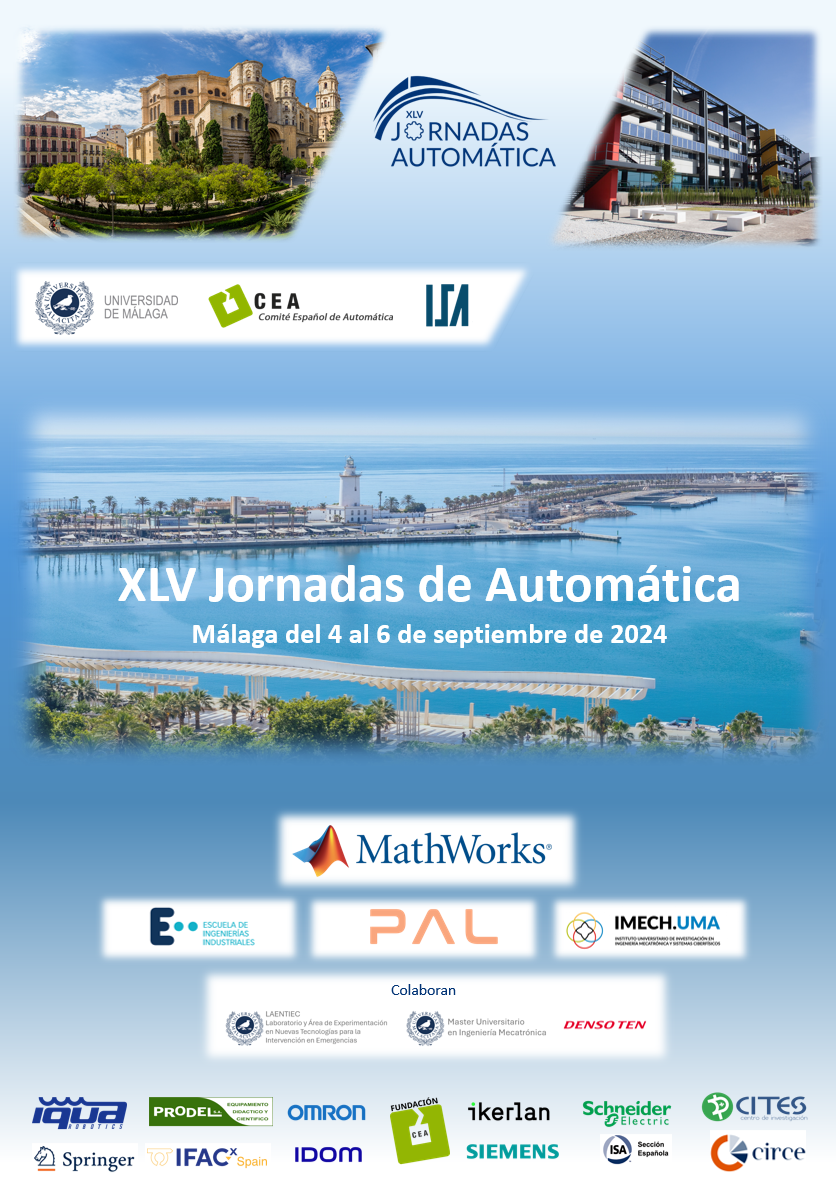Una propuesta para evaluar el aislamiento social y la soledad no deseada con el robot social Mini
DOI:
https://doi.org/10.17979/ja-cea.2024.45.10901Palabras clave:
Soledad no deseada, Aislamiento social, Robótica social, Interacción humano-robot, DepresiónResumen
El aislamiento social y la soledad no deseada son problemáticas crecientes que afectan significativamente al bienestar y la salud mental de las personas. En este trabajo se presenta una propuesta de una herramienta para evaluar el riesgo de padecer soledad no deseada de un usuario utilizando un robot social. Nuestra propuesta combina el uso de técnicas activas como cuestionarios y de técnicas pasivas empleando visión por computador y herramientas para analizar el estado emocional del usuario y la frecuencia de interacción tanto con el robot como con su círculo social. Se incluye el desarrollo de una aplicación que permite realizar cuestionarios al usuario para determinar si existe riesgo de padecer soledad no deseada. En nuestra propuesta de diseño, el objetivo es que el sistema sea capaz de detectar patrones de comportamiento del usuario y evaluar su nivel de interacción social. A partir de estos datos se extrae información sobre la situación del usuario. En caso de que haya riesgo de soledad no deseada o aislamiento social, el robot dispone de actividades de socialización, lo que representa una oportunidad para mejorar el bienestar del usuario.
Referencias
Association, A. P., et al., 2000. Diagnostic and statistical manual of mental disorders. Text revision.
Ball, C., Francis, J., Huang, K.-T., Kadylak, T., Cotten, S. R., Rikard, R., 2019. The physical–digital divide: Exploring the social gap between digital natives and physical natives. Journal of Applied Gerontology 38 (8), 1167–1184.
Card, K., Marziali, E., 2021. Research and Evaluation Manual: How to measure our impact on loneliness. The Social Bubble Project.
Carrasco-Martínez, S., Quispe-Flores, M., Sevilla Salcedo, J., Gómez-Jiménez, J., Alonso Martín, F., Salichs, M. Á., 2021. Comunicación remota entre familiares a través de la robótica social. In: XLII Jornadas de Automática. Universidade da Coruña, Servizo de Publicacións, pp. 565– 572.
Chen, S.-C., Moyle, W., Jones, C., Petsky, H., 2020. A social robot intervention on depression, loneliness, and quality of life for taiwanese older adults in long-term care. International psychogeriatrics 32 (8), 981–991.
de Jong-Gierveld, J., Van Tilburg, T. G., Dykstra, P. A., 2006. Loneliness and social isolation. In: The Cambridge handbook of personal relationships. Cambridge University Press, pp. 485–500.
Dellmar Walker PhD, R., 1991. The relationship of loneliness, social isolation, and physical health to dietary adequacy of independently living elderly. Journal of the American Dietetic Association 91 (3), 300–304.
Erzen, E., C ̧ ikrikci, ̈O., 2018. The effect of loneliness on depression: A metaanalysis. International Journal of Social Psychiatry 64 (5), 427–435.
Golden, J., Conroy, R. M., Bruce, I., Denihan, A., Greene, E., Kirby, M., Lawlor, B. A., 2009. Loneliness, social support networks, mood and well-being in community-dwelling elderly. International Journal of Geriatric Psychiatry: A journal of the psychiatry of late life and allied sciences 24 (7), 694–700.
Gray, J., Kim, J., Ciesla, J. R., Yao, P., 2016. Rasch analysis of the lubben social network scale–6 (lsns-6). Journal of Applied Gerontology 35 (5), 508–528.
Heylen, L., 2010. The older, the lonelier? risk factors for social loneliness in old age. Ageing & Society 30 (7), 1177–1196.
Kendall, A., Grimes, M., Cipolla, R., 2015. Posenet: A convolutional network for real-time 6-dof camera relocalization. In: Proceedings of the IEEE international conference on computer vision. pp. 2938–2946.
Leigh-Hunt, N., Bagguley, D., Bash, K., Turner, V., Turnbull, S., Valtorta, N., Caan, W., 2017. An overview of systematic reviews on the public health consequences of social isolation and loneliness. Public health 152, 157–171.
Lim, J., 2023. Effects of a cognitive-based intervention program using social robot pio on cognitive function, depression, loneliness, and quality of life of older adults living alone. Frontiers in public health 11, 1097485.
Lu, Z., Cao, L., Zhang, Y., Chiu, C.-C., Fan, J., 2020. Speech sentiment analysis via pre-trained features from end-to-end asr models. In: ICASSP 2020-2020 IEEE International Conference on Acoustics, Speech and Signal Processing (ICASSP). IEEE, pp. 7149–7153.
Mateo, A. M., 2023. Sistema para la detección de la depresión a partir del procesamiento, análisis y reconocimiento de patrones en señales fisiológicas.
National Academies of Sciences, Engineering, and Medicine, 2020. Social Isolation and Loneliness in Older Adults: Opportunities for the Health Care System. National Academies Press (US).
Qirtas, M., 2022. Detecting loneliness in people using technology. The Boolean: Snapshots of Doctoral Research at University College Cork, 97–104.
Qirtas, M. M., Zafeiridi, E., Pesch, D., White, E. B., 2022. Loneliness and social isolation detection using passive sensing techniques: scoping review. JMIR mHealth and uHealth 10 (4), e34638.
Quigley, M., Conley, K., Gerkey, B., Faust, J., Foote, T., Leibs, J., Wheeler, R., Ng, A. Y., et al., 2009. Ros: an open-source robot operating system. In: ICRA workshop on open source software. Vol. 3. Kobe, Japan, p. 5.
Salichs, M. A., Castro-Gonz ́alez, ́A., Salichs, E., Fern ́andez-Rodicio, E., Maroto-G ́omez, M., Gamboa-Montero, J. J., Marques-Villarroya, S., Castillo, J. C., Alonso-Mart ́ın, F., Malfaz, M., 2020. Mini: a new social robot for the elderly. International Journal of Social Robotics 12, 1231–1249.
Singer, C., 2018. Health effects of social isolation and loneliness. J. Aging Life Care 28, 4–8.
Steptoe, A., Shankar, A., Demakakos, P., Wardle, J., 2013. Social isolation, loneliness, and all-cause mortality in older men and women. Proceedings of the National Academy of Sciences 110 (15), 5797–5801.
Viera Delgado, B., et al., 2021. Factorización y validación de la ucla (versión 3): Autoestima y distorsiones de respuesta.
Yanguas, J., Cilvetti, A., Segura, C., December 2019. ¿A quiénes afecta la soledad y el aislamiento social? Aging Life Care Journal. URL: https://elobservatoriosocial.fundacionlacaixa.org/es/-/soledad-personas-mayores#
Descargas
Publicado
Número
Sección
Licencia
Derechos de autor 2024 Luis Alonso Ramos, Jesús García Martínez, José Carlos Castillo Montoya, Álvaro Castro González, Miguel Ángel Salichs

Esta obra está bajo una licencia internacional Creative Commons Atribución-NoComercial-CompartirIgual 4.0.





